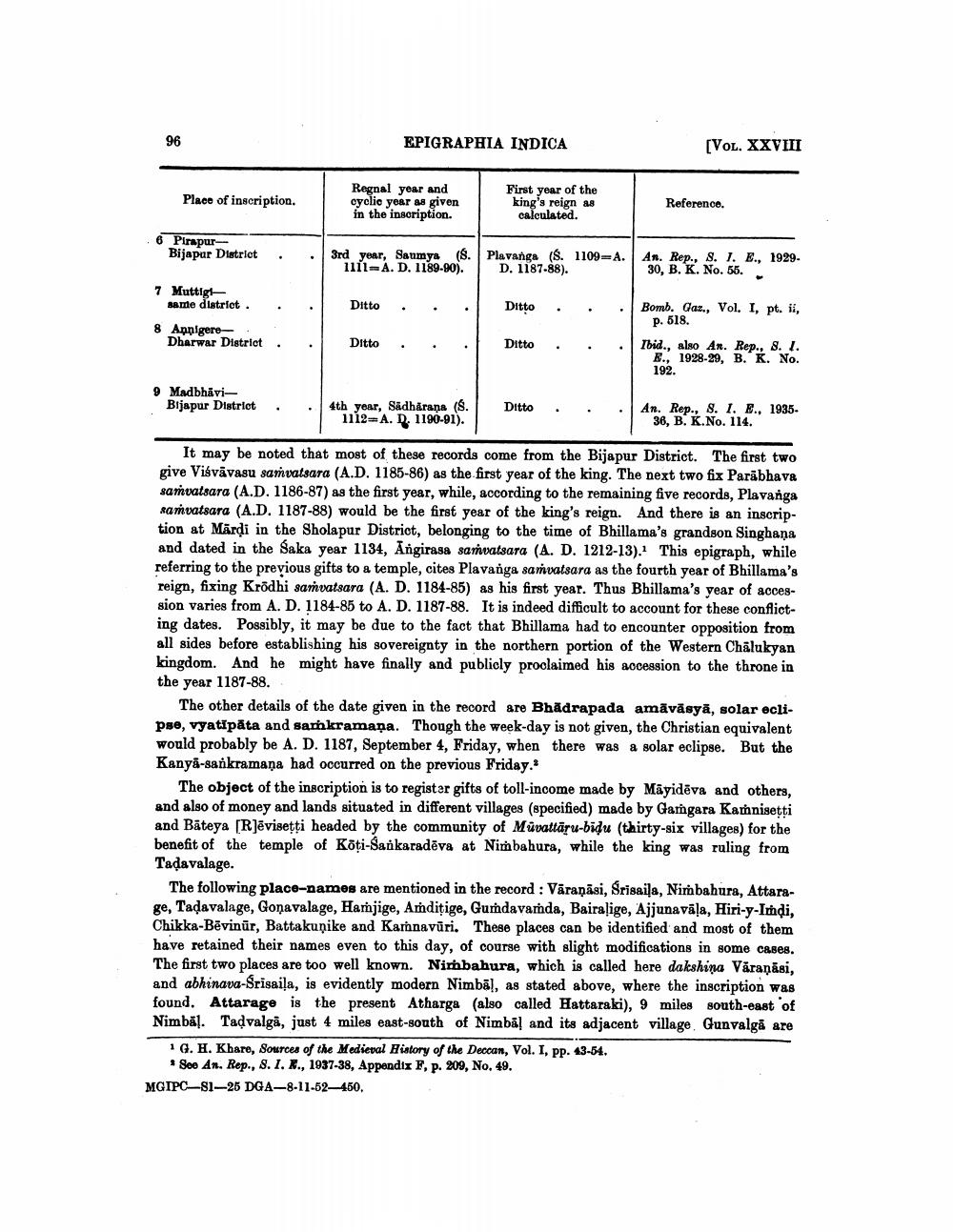________________
EPIGRAPHIA INDICA
[VOL. XXVIII
Place of inscription.
Regnal year and cyclio year as given in the inscription.
First year of the king's reign as calculated.
Reference.
6
PirapurBijapar District
.
.
3rd year, Saumya (8.
1111-A.D. 1189-90).
Plavanga (8. 1109-A.
D. 1187-88).
An. Rep., S. 1. E., 1929. 30, B. K. No. 55.
7 Muttigt
same district.
.
.
Ditto
.
.
.
Ditto
.
8 Apnigere .
Dharwar District .
.
Ditto
.
.
.
Ditto
.
.
Bomb. Gaz., Vol. I, pt. ii,
p. 518. Ibid., also Ar. Rep., 8.1.
E., 1928-29, B. K. No. 192.
9 Madbhāvi
Bijapur District
,
4th year, Sadharana (S.
1112A. R. 1190-91).
Ditto
.
.
An. Rep., 8. 1. E., 1935.
36, B. K.No. 114.
It may be noted that most of these records come from the Bijapur District. The first two give Visvävasu samvatsara (A.D. 1185-86) as the first year of the king. The next two fix Parābhava samvatsara (A.D. 1186-87) as the first year, while, according to the remaining five records, Plavanga ramvatsara (A.D. 1187-88) would be the first year of the king's reign. And there is an inscription at Mardi in the Sholapur District, belonging to the time of Bhillama's grandson Singhana and dated in the Saka year 1134, Angirasa samvatsara (A. D. 1212-13). This epigraph, while referring to the previous gifts to a temple, cites Plavanga samvatsara as the fourth year of Bhillama's reign, fixing Krödhi samvatsara (A. D. 1184-85) as his first year. Thus Bhillama's year of accession varies from A.D. 1184-85 to A. D. 1187-88. It is indeed difficult to account for these conflicting dates. Possibly, it may be due to the fact that Bhillama had to encounter opposition from all sides before establishing his sovereignty in the northern portion of the Western Chalukyan kingdom. And he might have finally and publicly proclaimed his accession to the throne in the year 1187-88.
The other details of the date given in the record are Bhadrapada amāvāsyā, solar eclipse, vyatipāta and samkramaņa. Though the week-day is not given, the Christian equivalent would probably be A. D. 1187, September 4, Friday, when there was a solar eclipse. But the Kanya-sankramana had occurred on the previous Friday.*
The object of the inscription is to register gifts of toll-income made by Māyidēva and others, and also of money and lands situated in different villages (specified) made by Gamgara Kannisetti and Bateya [R]ēvisetti headed by the community of Muvattaru-bidu (thirty-six villages) for the benefit of the temple of Köți-Sankaradēva at Nimbabura, while the king was ruling from Tadavalage.
The following place-namos are mentioned in the record : Väranäsi, Srisaila, Nimbahura, Attarage, Tadavalage, Gonavalage, Hamjige, Aíditige, Gumdavamda, Bairaļige, Ajjunavāļa, Hiri-y-Imdi, Chikka-Bēvinūr, Battakuņike and Kamnavūri. These places can be identified and most of them have retained their names even to this day, of course with slight modifications in some cases. The first two places are too well known. Nimbahura, which is called here dakshina Văranāsi. and abhinava-Srisaila, is evidently modern Nimbā), as stated above, where the inscription was found. Attarage is the present Atharga (also called Hattaraki), 9 miles south-east of Nimbal. Tadvalgå, just 4 miles east-south of Nimbā! and its adjacent village Gunvalgă are 1 G. . Khare, Sources of the Medieval History of the Deccan, Vol. I, pp. 43-54.
Soo An. Rep., 8.1. X., 1937-38, Appendix F, p. 209, No. 49. MGIPC-81—25 DGA—8-11-52—450.




